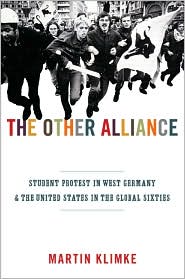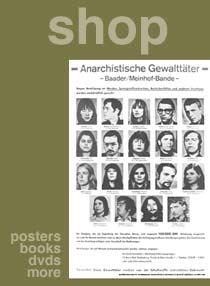The Other Alliance:
Student Protests in West Germany & The United States in the Global Sixties
Listen to an interview with author Martin Klimke: 45 minutes
The post-war alliance between former combatants (West) Germany and the United states has been well-documented through hundreds of book and scholarly works devoted to the Cold War. But German author Martin Klimke has detailed an equally rich and heretofore unexplored parallel alliance between the burgeoning student movements of West Germany and the United States. Klimke's new English language book, "The Other Alliance: Student Protests in West Germany & The United States in the Global Sixties," is a fantastic new addition to the slim canon of English works devoted to the roots of the German student movement which provided the engine for the Baader-Meinhof era.
The German student movement and the American student movement of the sixties followed parallel paths from tentative questioning of the status quo to full-blow anarchic street protests. Both movements helped incubate the subculture of radicalism that led to significant urban terrorist factions. But typically both movements are described as almost developing in a vacuum; arising essentially independently of each other. Yet Klimke's book cleanly and definitively demonstrates that much of these twin histories were in fact deeply entwined with each other. As someone who has read almost every printed English language work about the Baader-Meinhof era, I confess that much of Klimkes scholarship is entirely new and entirely surprising to me. And surprising me about the roots of the Baader-Meinhof era is a hard thing to do.
It's always been interesting to note the coincidence of the identical acronyms of the leading German and American student organizations. The German SDS was an acronym for Sozialistischer Deutscher Studentenbund, or German Socialist Student Organization, and the American SDS stood for Students for a Democratic Society. Both of these groups occupied roughly similar positions in their respective societies, and both were aligned with their country's leading left political party before breaking with them and following more progressive paths.Yet their histories are typically described entirely independent of each other. But, as Klimke careful details, these two organizations has deep connections and were heavily influenced by each other.
Patient Zero for both organizations was Michael Vester, a German exchange student who attended Bowdoin College in 1961. As the Vice Chairman of the German SDS, Vester took it upon himself to visit the New York offices of the American SDS, developing close bonds with legendary student leaders Al Haber and Tom Hayden. Vester became heavily involved in the American SDS, helping organize chapters, and ultimately helping to develop and edit the famous Port Huron statement. Like many German students, Vester's held a deep knowledge and appreciation of Herbert Marcuse and the other titans of the Frankfurt School; Vester's knowledge of critical theory was readily incorporated into developing drafts of the Port Huron statement.
As the sixties wore on, both student movements began to get more organized and more aggressive. Klimke shows how American concepts of Direct Action were utilized by German student leaders like Rudi Deutsche in their efforts to push the German SDS into a more anti-authoritarian direction. And in America, the student movement followed the example of the German movement by incorporating Critical Theory into their ideology and finding inspiration with third world revolutionary movements.
Klimkes also clearly demonstrates how influential the American Civil Rights and Black Power movements were among the increasingly radical German student movement. The Black Panthers set a particularly potent example for many of the Germans. They seemed to be setting up an alternate armed society within the main society while thoroughly opposed to the main society. Yet they were supported by much of their own population. For proto-revolutionaries like Horst Mahler, Gudrun Ennslin, and Andreas Baader, this must have been exciting, empowering stuff. Klimke shows how Germans readily idealized and almost fetishized the Black Power movement and their leaders, and how many of their tactics found their way into the tactics of the new German proto-revolutionary terror groups.
Virtually all of Klimke's research into the influence of the Black Power movement is new to me. It feels so obvious in retrospect, but I can't remember any other work ever exploring this connection at all, let alone in detail. For student of the Baader-Meinhof era it provides true insight into the milieu that helped foster the coming decade of terror.
In my interview with Dr. Klimke it occurred to me why so much of his scholarship felt so fresh and well-reasoned: as someone who was born a full decade after the era he covers, Klimke is unencumbered by the inherent biases that cloud the analyses of so many scholars of the era, me included (though I was born in 1968, I am fully aware that my personal history with left-wing German terrorism influences my research). Klimke is part of the coming and welcome wave of scholars that can evaluate this challenging and important time with mindset of a true historian.



